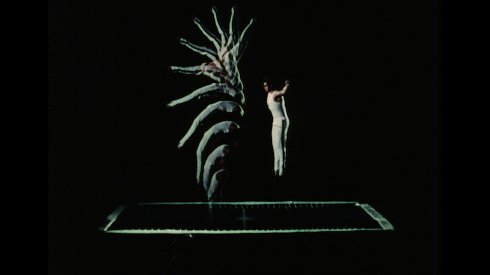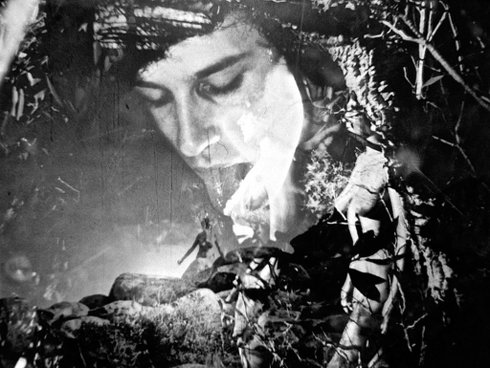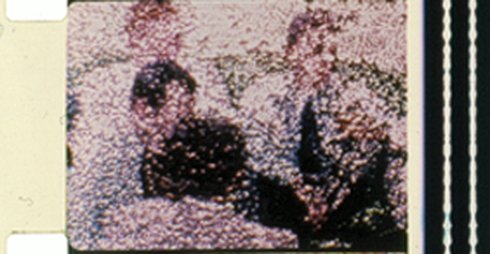Artists in focus
 Eve Heller (*1961), a US filmmaker with dual citizenship based in Austria since 2005 – who can boast teachers including Paul Sharits, Tony Conrad, Keith Sanborn, Peter Hutton, Peggy Ahwesh and Abigail Child – has remained true to analog (and occasionally hand-processed) film. Using a JK optical printer she imported to Austria, Heller penetrates found footage frame by frame, enlarging the details of images – at times to extremes bordering on abstraction. Through her painstaking editing of slowed-down imagery and layers of multiple images, Heller re-contextualizes the visual vocabulary of her source material, rendering dreamlike atmospheres that distill entirely new poetic and narrative implications while making palpable the materiality of her 16mm medium. When she workes without the aid of the printer, hacking directly into the film material and editing the material into brief fragments, Heller divorces the intended marriage of sound and picture, revealing its illusion by breaking down and reshuffling the elements, in a manner reminiscent of William Burrough’s cut-up technique. She thereby materially generates a rhythmical poetry teetering on the borderline between sense and nonsense. It makes yet a deeper and different kind of sense that the daughter of a refugee from Nazi Austria, upon moving back to her father’s native Vienna, presents her films for the first time in her mother’s native town, Munich. (Peter Tscherkassky) |
PETER
TSCHERKASSKY
Saturday 10 oct | 8 pm | filmmuseum münchen
 Peter Tscherkassky One of the special pleasures of working with found footage lies in the creation of entirely new stories distilled from "found" images. But for me, no less important is my physical contact with the film material itself. In a certain sense, I see myself as a kind of sculptor when working with analog found footage. I take the raw material in hand – literally and figuratively grasping it – to shape new images and forms from the admittedly thin but nonetheless corporeal strip of film: I sculpt with light in a darkroom using various lasers, flashlights and mattes to assemble collages from a great variety of sources which I contact print onto raw stock. In the process, I try to make the unique corporeality of the film strip visible – as a sequence of static individual images, with its emulsion, its boundaries, its vertical arrangement, the perforations, the stripe of the optical soundtrack, dust particles, scratches, dents, etc. Later, when the completed film is projected, the big screen plays host to a two-dimensional sculpture of time, distilled in the darkroom to such a degree that the viewer who is open can experience it physically: as if the body of the film might directly electrify the body of the public. This is what I call "physical cinema", and it is this sensorial experience of watching film that I consider one of its most elemental aspects ¬– in addition to its content, its "story". And it is what the cinema is all about: an irreplaceable site for film to be experienced as a radical art-form. (Peter Tscherkassky, transl. by Eve Heller) |
PHIL
SOLOMON
Sunday 11 oct | 7 pm | werkstattkino
 Phil Solomon (1954 – 2019) was an internationally recognized filmmaker and has been teaching both film history/aesthetics and film production at CU since 1991. Solomon's work has been screened in every major venue for experimental film throughout the U.S. and Europe, including the Museum of Modern Art and two Whitney Biennials. Solomon's films have won ten first prize awards at major international film festivals for experimental film. His films reside in the permanent collections of the Museum of Modern Art, Massachusetts College of Art, Binghamton University, Hampshire College, The Chicago Art Institute, San Francisco State University, and the Oberhausen Film Collection. Solomon collaborated on three films with his colleague and friend, Stan Brakhage, who named Solomon's “Remains to be Seen” on his Top Ten Films of All Time for “Sight and Sound”. In 2007, Phil Solomon embarked on an award winning series of digital videos culled from the video game “Grand Theft Auto” entitled “In Memoriam, Mark Lapore”, which was named in the Top Ten experimental films of the year by the “Village Voice”. |
